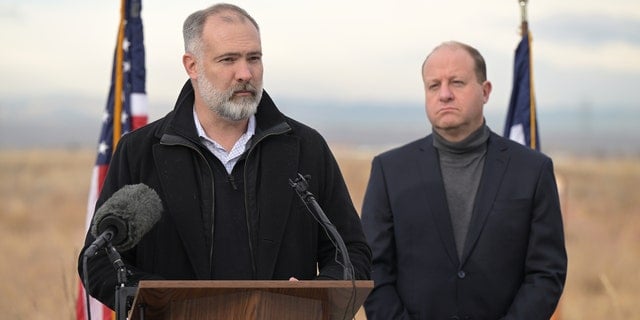

Photo: Deputy Secretary of the Interior Tommy Beaudreau speaks alongside Colorado Gov. Jared Polis in Commerce City, Colorado, on Dec. 14, 2022. (Hyoung Chang/The Denver Post via Getty Images)
The Biden administration proposed actions Tuesday that would significantly reduce water supplies in seven western states amid severe drought conditions that stretch back decades.
The Department of the Interior (DOI) released a draft proposal that highlighted two potential actions it could take to combat the Colorado River Basin’s deteriorating water levels. The two proposals would each consist of federally-mandated supply reductions for states that are dependent on the river system which provides water for more than 40 million Americans and is vital for western states’ economies.
“Failure is not an option,” Tommy Beaudreau, the DOI’s deputy secretary, said in a statement. “Recognizing the severity of the worsening drought, the Biden-Harris administration is bringing every tool and every resource to bear through the President’s Investing in America agenda to protect the stability and sustainability of the Colorado River System now and into the future.”
In addition to the water it supplies to millions of Americans, the 1,450-mile Colorado River supports 5.5 million acres of agricultural lands, provides electricity to millions of residents through hydroelectric dams and has key recreational and ecological uses.
Overall, the river provides water resources to seven states which are divided into two groups: the Upper Basin and Lower Basin. The Upper Basin consists of Colorado, New Mexico, Utah and Wyoming while the Lower Basin includes Arizona, California, and Nevada.
While Upper Basin states mainly receive water from smaller rivers that branch off the Colorado River, the Lower Basin states largely receive water pooled in Lake Powell, a man-made reservoir along the Utah-Arizona border, and Lake Mead, a reservoir along the Nevada-Arizona border. The Glen Canyon Dam in northern Arizona and Hoover Dam in southern Nevada are able to control water flows from the respective […]
Full article: Biden admin outlines plan to cut vital water supplies in western states
Clean water is essential for life, yet millions of Americans unknowingly consume contaminants through their…
Human brains contain higher concentrations of microplastics than other organs, according to a new study, and the…
From the Office of the Governor: In anticipation of a multi-day, significant atmospheric river in Northern California,…
From Governor Newsom: Scientists, water managers, state leaders, and experts throughout the state are calling…
Photo: A harmful algal bloom in Milford Lake, Kansas, made the water appear bright green.…
An expanded plastic foam coffee cup is at a donut shop in Monterey Park, California.…